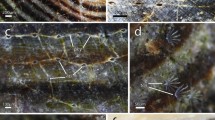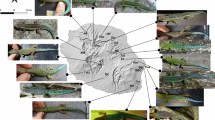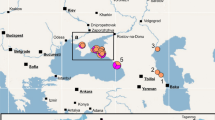Abstract
In spite of historical and current interest in Ciona intestinalis and its congeners, little is known about evolutionary relationships among the members of the genus Ciona. Here 744-bp sequences of the mitochondrial cytochrome c oxidase subunit I (COI) gene are used to examine phylogenetic relationships among three described species (C. intestinalis, C. roulei, C. savignyi) sampled from multiple coastal sites in the Northeast Pacific (CA, USA), Northwest Atlantic (from New Hampshire to Connecticut, USA), Northeast Atlantic (Sweden and The Netherlands), and Mediterranean (Banyuls-sur-Mer, France). The samples were collected in June–October 2005. The COI sequences of Northeast Pacific/Mediterranean (Type A) and Northwest Atlantic (Type B) C. intestinalis differ by ∼12% and C. roulei is nested within Type B C. intestinalis. Ciona savignyi differs from all other haplotypes by 13–16%. A previously undescribed but morphologically distinct Ciona sp. found at the Banyuls-sur-Mer site was >10% divergent from all other haplotypes. Although these data arise from a single gene study, they indicate that further elucidation of species relationships within the genus and of the species’ distributions will be needed if continuing invasions and potential reproductive isolation are to be investigated.


Similar content being viewed by others
References
Arndt A, Marquez C, Lambert P, Smith MJ (1996) Molecular phylogeny of eastern Pacific sea cucumbers (Echinodermata: Holothuroidea) based on mitochondrial DNA sequence. Mol Phylogenet Evol 6:425–437
Biermann CH, Kessing BD, Palumbi SR (2003) Phylogeny and development of marine model species: strongylocentrotid sea urchins. Evol Dev 5:360–371
Boffelli D, Weer CV, Weng L, Lewis K, Shoukry MI, Pachter L, Keys DN, Rubin EM (2004) Intraspecies sequence comparisons for annotating genomes. Genome Res 14:2406–2411
Bucklin A, Guarnieri M, Hill RS, Bentley AM, Kaartvedt S (1999) Taxonomic and systematic assessment of planktonic copepods using mitochondrial COI sequence variation and competitive species-specific PCR. Hydrobiologia 401:239–254
Burton R (1995) Genetic differentiation and reproductive incompatibility among Baja California populations of the copepod Tigriopus californicus. Mar Biol 123:821–827
Byrd J, Lambert CC (2000) Mechanism of the block to hybridization and selfing between the sympatric ascidians Ciona intestinalis and Ciona savignyi. Mol Reprod Dev 55:109–116
Chabry L (1887) Contribution a l’embrologie normale teratologique des ascidies simples. J Anat Physiol Norm Path 23:167–319
Copello M (1981) Ciona edwardsi (Roule, 1886) Espece littorale de Mediterranee distincte de Ciona intestinalis (Linne, 1767). Vie Milieu B Oceanog 31:243–253
Dawson MN, Jacobs DK (2001) Molecular evidence for cryptic species of Aurelia aurita (Cnidaria, Scyphozoa). Biol Bull 200:92–96
Dehal P, Satou Y, Campbell RK, Chapman J, Degnan B, De Tomaso A, Davidson B, Di Gregorio A et al (2002) The draft genome of Ciona intestinalis: insights into chordate and vertebrate origins. Science 298:2157–2167
Edmands S, Moberg PE, Burton RS (1996) Allozyme and mitochondrial DNA evidence of population subdivision in the purple sea urchin Strongylocentrotus purpuratus. Mar Biol 126:443–450
Fiala-Medioni A (1974) Ascidians of the rocky benthos of Banyuls-sur-Mer. Faunistic inventory and ecology notes. Vie Milieu B Oceanogr 24:193–207
Gissi C, Pesole G (2003) Transcript map** and genome annotation of ascidian mtDNA using EST Data. Genome Res 13:2203–2212
Glover AG, Goetze E, Dahlgren TG, Smith CR (2005) Morphology, reproductive biology and genetic structure of the whale-fall and hydrothermal vent specialist, Bathykurila guaymasensis Pettibone, 1989 (Annelida: Polynoidae). Mar Ecol P S Z N I 26:223–234
Harant H, Vernieres P (1933) Tuniciers. Faune de France 27:1–93
Hart MW, Byrne M, Smith MJ (1997) Molecular phylogenetic analysis of life history evolution in Asterinid starfish. Evolution 51:1848–1861
Hellberg ME (1998) Sympatric sea shells along the sea’s shore: the geography of speciation in the marine gastropod Tegula. Evolution 52:1311–1324
Hill RS, Allen LD, Bucklin A (2001) Multiplexed species-specific PCR protocol to discriminate four N. Atlantic Calanus species, with an mtCOI gene tree for ten Calanus species. Mar Biol 139:279–287
Hoeh WR, Stewart DT, Sutherland BW, Zouros E (1996) Cytochrome c oxidase sequence comparisons suggest an unusually high rate of mitochondrial DNA evolution in Mytilus (Mollusca: Bivalvia). Mol Biol Evol 13:418–421
Holland BS, Dawson MN, Crow GL, Hofmann DK (2004) Global phylogeography of Cassiopea (Scyphozoa: Rhizostomeae): molecular evidence for cryptic species and multiple invasions of the Hawaiian Islands. Mar Biol 145:1119–1128
Hoshino ZI, Nishikawa T (1985) Taxonomic studies of Ciona intestinalis (L.) and its allies. Publ Seto Mar Biol Lab 30:61–79
Hurtado LA, Lutz RA, Vrijenhoek RC (2004) Distinct patterns of genetic differentiation among annelids of eastern Pacific hydrothermal vents. Mol Ecol 13:2603–2615
Hurtado LA, Mateos M, Lutz RA, Vrijenhoek RC (2002) Molecular evidence for multiple species of Oasisia (Annelida: Siboglinidae) at eastern Pacific hydrothermal vents. Cah Biol Mar 34:377–380
Jeffery WR, Swalla BJ (1990) Anural development in ascidians: evolutionary modification and elimination of the tadpole larva. Sem Dev Biol 1:253–261
Johnson DS, Davidson B, Brown C, Smith W, Sidow A (2004) Noncoding regulatory sequences of Ciona exhibit strong correspondence between evolutionary constraint and functional importance. Genome Res 14:2448–2456
Jolly MT, Jollivet D, Gentil F, Thiebaut E, Viard F (2005) Sharp genetic break between Atlantic and English Channel populations of the polychaete Pectinaria koreni, along the North coast of France. Heredity 94:23–32
King TL, Eackles MS, Gjetvaj B, Hoeh WR (1999) Intraspecific phylogeography of Lasmigona subviridis (Bivalvia: Unionidae): conservation implications of range discontinuity. Mol Ecol 8:S65
Kott P (1952) The Ascidians of Australia. Aust J Mar Fresh Res 3:206–233
Kumar S, Tamura K, Nei M (2004) MEGA3: integrated software for molecular evolutionary genetics analysis and sequence alignment. Brief Bioinform 5:150–163
Lambert G (2001) A global overview of ascidian introductions and their possible impact on the endemic fauna. In: Sawada H, Yokosawa H, Lambert CC (eds) Proceedings of the first international symposium on the biology of ascidians. Springer, Tokyo, pp 249–257
Lambert CC, Lambert G (2003) Persistence and differential distribution of nonindigenous ascidians in harbors of the Southern California Bight. Mar Ecol Prog Ser 259:145–161
Lambert G, Lambert CC, Abbott D (1981) Corella species in the American Pacific Northwest: distinction of C. inflata Huntsman, 1912 from C. willmeriana Herdman 1898 (Ascidiacea, Phlebobranchiata). Can J Zool 59:1493–1504
Lambert CC, LaFargue F, Lambert G (1990) Preliminary note on the genetic isolation of Ciona species (Ascidiacea, Urochordata). Vie Milieu B Oceanogr 40:293–295
Landry C, Geyer LB, Arakaki Y, Uehara Y, Palumbi SR (2003) Recent speciation in the Indo-West Pacific: rapid evolution of gamete recognition and sperm morphology in cryptic species of sea urchin. Proc R Soc Lond B 270:1839–1847
Lee CE (2000) Global phylogeography of a cryptic copepod species complex and reproductive isolation between genetically proximate ‘populations’. Evolution 54:2014–2027
Lessios HA, Kessing BD, Robertson DR, Paulay G (1999) Phylogeography of the pantropical sea urchin Eucidaris in relation to land barriers and ocean currents. Evolution 53:806–817
Lessios HA, Kessing BD, Pearse JS (2001) Population structure and speciation in tropical seas: global phylogeography of the sea urchin Diadema. Evolution 55:955–975
Linnaeus C (1767) Systema Naturae. Vindobonae: Typis Ioannis Thomae, pp 1767–1770
McCartney MA, Keller G, Lessios GA (2000) Dispersal barriers in tropical oceans and speciation in Atlantic and eastern Pacific sea urchins of the genus Echinometra. Mol Ecol 9:1391–1400
Medina M, Weil E, Szmant AM (1999) Examination of the Montastraea annularis species complex (Cnidaria: Scleractinia) using ITS and COI sequences. Marine Biotechnol 1:89–97
Metz E (1998) Mitochondrial DNA and bindin gene sequence evolution among allopatric species of the sea urchin genus Arbacia. Mol Biol Evol 15:185–195
Minganti A (1948) Interspecific fertilization in ascidians. Nature 161:643–644
Missal K, Rose D, Stadler P (2005) Non-coding RNAs in Ciona intestinalis. Bioinformatics 21:i77–i78
Monniot C (1990) Ascidies de Nouvelle-Caledonie. 8. Phlebobranches (suite). B Mus Natl Hist Nat 12:491–515
Monniot C, Monniot F (1977) Tuniciers benthiques profonds du Nord-Est Atlantique. Resultats des campagnes Biogas. B Mus Natl Hist Nat 323:695–720
Monniot C, Monniot F (1983) Ascidies antarctiques et subantarctiques: morphologie et biogeographie. Mem Mus Natn Hist Nat Ser A 125:1–168
Monniot C, Monniot F (1989) Ascidians collected around the Galapagos Islands using the Johnson Sea Link research submersible. P Biol Soc Wash 102:14–32
Morgan TH (1904) Self-fertilization induced by artificial means. J Exp Zool 1:135–178
O’Foighil D, Gaffney PM, Wilbur AE, Hilbish TJ (1998) Mitochondrial cytochrome oxidase I gene sequences support an Asian origin for the Portuguese oyster Crassostrea angulata. Mar Biol 131:497–503
Palumbi SR, Grabowsky G, Duda T, Geyer L, Tachino N (1997) Speciation and population genetic structure in tropical Pacific sea urchins. Evolution 51:1506–1517
Posada D, Crandall KA (1998) MODELTEST: testing the model of DNA substitution. Bioinformatics 14:817–818
Rozas J, Rozas R (1999) DnaSP version 3: an integrated program for molecular population genetics and molecular evolution analysis. Bioinformatics 15:174–175
Sanamyan K (1998) Ascidians from the north-western Pacific region. 5. Phlebobranchia. Ophelia 49:97–116
Schneider S, Roessli D, Excoffier L (2000) Arlequin: a software for population genetics data analysis, ver 2.000. Genetics and Biometry Lab, Department of Anthropology, University of Geneva
Sordino P, Heisenberg CP, Cirino P, Toscano A, Giuliano P, Marino R, Pinto MR, De-Santis R (2000) A mutational approach to the study of development of the protochordate Ciona intestinalis (Tunicata, Chordata). Sarsia 85:173–176
Suzuki M, Nishikawa T, Bird A (2005) Genomic approaches reveal unexpected genetic divergence within Ciona intestinalis. J Mol Evol 61:627–635
Swofford DL (2003) PAUP*: phylogenetic analysis using parsimony and other methods), version 4.0b 10. Sinauer Associates, Sunderland
Tarjuelo I, Posada D, Crandall KA, Pascual M, Turon X (2001) Cryptic species of Clavelina (Ascidiacea) in two different habitats: harbours and rocky littoral zones in the northwestern Mediterranean. Mar Biol 139:455–462
Tarjuelo I, Posada D, Crandall KA, Pascual M, Turon X (2004) Phylogeography and speciation of colour morphs in the colonial ascidian Pseudodistoma crucigaster. Mol Ecol 13:3125–3136
Van Name W (1945) The north and south American ascidians. B Am Mus Nat Hist 84:1–476
van Syoc RJ (1994) Genetic divergence between subpopulations of the eastern Pacific goose barnacle Pollicipes elegans: mitochondrial cytochrome c subunit 1 nucleotide sequences. Mol Mar Biol Biotech 3:338–346
Vinson J, Jaffe D, O’Neill K, Karlsson E, Stange-Thomann N, Anderson S, Mesirov J, Satoh N, Satou Y, Nusbaum C, Birren B, Galagan J, Lander E (2005) Assembly of polymorphic genomes: algorithms and application to Ciona savignyi. Genome Res 15:1127–1135
Yokobori S-i, Ueda T, Feldmaier-Fuchs G, Paeaebo S, Ueshima R, Kondow A, Nishikawa K, Watanabe K (1999) Complete DNA sequence of the mitochondrial genome of the ascidian Halocynthia roretzi (Chordata, Urochordata). Genetics 153:1851–1862
Yokobori S-i, Watanabe Y, Oshima T (2003) Mitochondrial genome of Ciona savignyi (Urochordata, Ascidiacea, Enterogona): comparison of gene arrangement and tRNA genes with Halocynthia roretzi mitochondrial genome. J Mol Evol 57:574–587
Yokobori S-i, Oshima T, Wada H (2005) Complete nucleotide sequence of the mitochondrial genome of Doliolum nationalis with implications for evolution of urochordates. Mol Phylogenet Evol 34:273–283
Zigler KS, Raff EC, Popodi E, Raff RA, Lessios HA (2003) Adaptive evolution of bindin in the genus Heliocidaris is correlated with the shift to direct development. Evolution 57:2293–2302
Zigler KS, Lessios HA (2004) Speciation on the coasts of the new world: phylogeography and the evolution of bindin in the sea urchin genus Lytechinus. Evolution 58:1225–1241
Acknowledgments
We thank A. Fiala-Medioni, P. Romans, and J-C. Roca at the Observatoire Océanologique de Banyuls-sur-mer for their generous intellectual and logistic support. We are also indebted to X. Turon and M. Pascual for helpful discussions and travel assistance, to A. Gittenberger and C. Dahlberg for Northeast Atlantic C. intestinalis samples, to J. Friel and C. Dardia for sample preservation advice, to B. Swalla, C. and G. Lambert, J. Carlton and P. Sordino for illuminating Ciona discussions. We thank members of the Harrison Lab, A. Clark, B. Swalla, P. Sordino, J. Grassle and two anonymous reviewers for providing comments on the manuscript. This research was funded by a Cornell University Sigma ** Grant to M.L.N. All experiments complied with current laws of the country from which the samples were collected.
Author information
Authors and Affiliations
Corresponding author
Additional information
Communicated by J.P. Grassle.
Rights and permissions
About this article
Cite this article
Nydam, M.L., Harrison, R.G. Genealogical relationships within and among shallow-water Ciona species (Ascidiacea). Mar Biol 151, 1839–1847 (2007). https://doi.org/10.1007/s00227-007-0617-0
Received:
Accepted:
Published:
Issue Date:
DOI: https://doi.org/10.1007/s00227-007-0617-0




